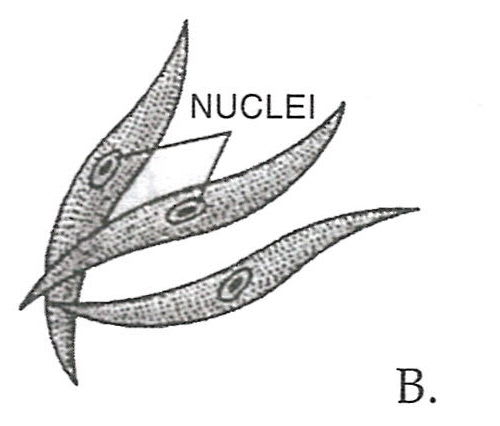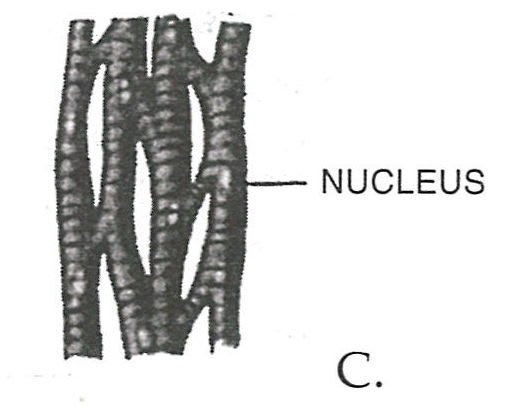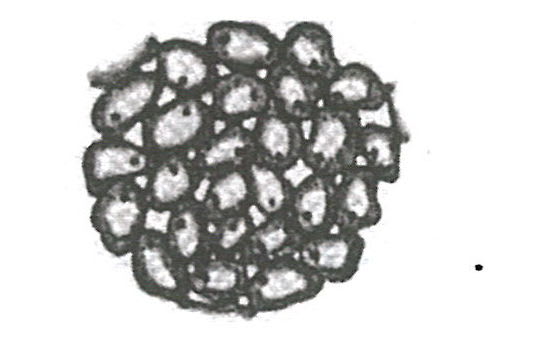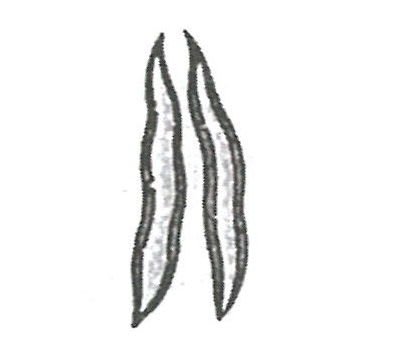A group of similar cells to perform a specific function forms a:
- Organ
- Species
- Organ system
- Tissue
Answer
Tissue
Reason — Similar cells organise to form tissue and perform a specific function.
The small fine branches given out from the cell body of a nerve cell are:
- Dendrites
- Cyton
- Axon
- Neurons
Answer
Dendrites
Reason — Dendrites are fine hair-like extensions from cyton.
Fluid connective tissue of humans is:
- Blood and cartilage
- Lymph and plasma
- Blood and lymph
- Stroma and matrix
Answer
blood and lymph
Reason — Blood (cells+plasma) and Lymph are the fluid connective tissue that are concerned with transportation of oxygen, glucose and amino acids etc.
Tissues organise to form :
- Organ system
- Organs
- Organism
- Cells
Answer
Organs
Reason — Tissues organise to form organs.
In which of the plant tissues, cells actively divide to form new cells ?
- Parenchyma
- Sclerenchyma
- Meristematic tissue
- Protective tissue
Answer
Meristematic tissue
Reason — Meristematic tissues are made up of actively dividing cells. Their only function is to produce more cells leading to the growth of the plant body.
Which of the following tissues consists of dead cells ?
- Collenchyma
- Meristems
- Parenchyma
- Sclerenchyma
Answer
Sclerenchyma
Reason — Sclerenchyma is composed of long, narrow and thick-walled dead cells to provide strength to the plant parts.
Which of the following tissues is found in the lining of the trachea ?
- Ciliated epithelium
- Cuboidal epithelium
- Columnar epithelium
- Squamous epithelium
Answer
Ciliated epithelium
Reason — In the lining of the trachea, the columnar epithelium has developed cilia. Such an epithelium is called ciliated epithelium.
Which of the following is not a kind of a fibrous connective tissue ?
- Areolar tissue
- Cartilage
- Tendons
- Ligaments
Answer
Cartilage
Reason — Cartilage is a Supportive connective tissue. It covers the ends of bones, and gives support to certain organs.
The non-cellular part of blood is :
- Lymph
- Serum
- Plasma
- Tissue fluid
Answer
Plasma
Reason — Plasma is the non-cellular (liquid) part of the blood.
The tissue in which the cells are filled with fat globules is :
- Epithelial tissue
- Adipose tissue
- Nervous tissue
- Areolar tissue
Answer
Adipose tissue
Reason — Adipose tissue contains cells filled with fat globules.
State whether the following statement are True or False.
- A tissue is formed of only one type of cells.
- Only one type of tissue forms an organ.
- Permanent tissue is made up of undifferentiated and dividing cells.
- Meristematic tissue is found at the growing tips of a plant.
- Phloem is formed of dead tubular cells.
Answer
True
True
False
Corrected statement — Permanent tissue is made up of differentiated and non-dividing cells.True
False
Corrected statement — Phloem is formed of living tubular cells.
Fill in the blanks by selecting suitable words from the list given below:
[thin-walled, collenchyma, vascular, tissues, conducting]
- A group of different ............... working together to perform a function is called an organ.
- Xylem and phloem form the ............... tissue.
- Conducting tissue is also called ............... tissue.
- Cells are elongated and thick at the corners in ............... tissue.
- Parenchyma is composed of large ............... cells.
Answer
- tissues
- conducting
- vascular
- collenchyma
- thin-walled
Match the items given in Column A with those given in Column B:
| Column A | Column B |
|---|---|
| (i) Fibrous connective tissue | (a) blood |
| (ii) Fluid connective tissue | (b) cartilage |
| (iii) Supportive connective tissue | (c) connects a bone to another bone |
| (iv) Ligament | (d) areolar tissue |
| (v) Tendon | (e) connects a muscle with a bone |
Answer
| Column A | Column B |
|---|---|
| (i) Fibrous connective tissue | (d) areolar tissue |
| (ii) Fluid connective tissue | (a) blood |
| (iii) Supportive connective tissue | (b) cartilage |
| (iv) Ligament | (c) connects a bone to another bone |
| (v) Tendon | (e) connects a muscle with a bone |
Each of the tissues listed in Column A is related to one of the functions given in Column B. Match the correct pairs by drawing lines.
| Column A (Tissue) | Column B (Function) |
|---|---|
| (i) Epithelial tissue | (a) movement |
| (ii) Connective tissue | (b) protection |
| (iii) Vascular tissue | (c) messages |
| (iv) Nervous tissue | (d) support |
| (v) Muscular tissue | (e) transport |
Answer
| Column A (Tissue) | Column B (Function) |
|---|---|
| (i) Epithelial tissue | (b) protection |
| (ii) Connective tissue | (d) support |
| (iii) Vascular tissue | (e) transport |
| (iv) Nervous tissue | (c) messages |
| (v) Muscular tissue | (e) movement |
Name the kind of tissue that
Carries oxygen around your body
Brings about movement in animals
Transports food to different parts of a plant
Transports water in plants
Supports an animal's body
Binds different tissues together
Conducts messages from one part of the body to another
is found on the surface of roots, stems and leaves.
is composed of elongated cells, that are thick at the corners.
is composed of dead cells, that provides strength to the plant parts.
is richly located in the brain and spinal cord.
is striated and branched.
Answer
Carries oxygen around your body — Fluid connective tissue
Brings about movement in animals — Muscular tissue
Transports food to different parts of a plant — Phloem
Transports water in plants — Xylem
Supports an animal's body — Supportive connective tissue
Binds different tissues together — Fibrous connective tissue
Conducts messages from one part of the body to another — Nervous tissue
is found on the surface of roots, stems and leaves — Protective Tissue
is composed of elongated cells, that are thick at the corners — Collenchyma
is composed of dead cells, that provides strength to the plant parts — Sclerenchyma
is richly located in the brain and spinal cord — Nervous tissue
is striated and branched — Cardiac muscular tissue
Based on the following information, identify the three types of epithelial tissue in the figures given below:
(i) Cuboidal epithelium: It consists of a single layer of cuboidal cells.
(ii) Columnar epithelium: It is composed of tall, cylindrical cells with oval nuclei usually placed at the base of the cells.
(iii) Ciliated epithelium: It consists of cells bearing hair-like cilia on their free surface.

(a) ..............

(b) ..............

(c) ..............
Answer
(a) Cuboidal epithelium
(b) Columnar epithelium
(c) Ciliated epithelium
Given below are sets of four terms. Choose the odd one and write the category for the remaining terms :
- Ligaments, Cardiac muscles, Tendons, Areolar tissue.
- Collenchyma, Protective tissue, Sclerenchyma, Parenchyma.
- Cuboidal tissue, Connective tissue, Columnar tissue, Ciliated tissue.
- Striated, Cartilage, Cardiac, Unstriated muscle.
- Cytons, Axons, Tendons, Dendrons.
Answer
Odd one — Cardiac muscles
Category of the remaining terms — Fibrous Connective tissuesOdd one — Protective tissue
Category of the remaining terms — Supporting tissuesOdd one — Connective tissue
Category of the remaining terms — Epithelial tissuesOdd one — Cartilage
Category of the remaining terms — Muscular tissuesOdd one — Tendons
Category of the remaining terms — Parts of a Nerve cell/Neuron
Arrange the following terms in a proper logical sequence :
- Organ system, Tissues, Cells, Organisms, Organs.
- Cambium layer, Pith, Outer Bark, Inner bark.
Answer
- Cells, Tissues, Organs, Organ system, Organisms.
- Pith, Cambium layer, Inner bark, Outer bark.
Note the relationship between the first two words and suggest a suitable word/words for the fourth place:
- Bones : Skull :: Cartilage : ............... .
- Covering : Epithelial :: Contractile : ............... .
- Xylem : Vessels :: Phloem : ............... .
- Cuboidal epithelium : Absorption :: Columnar epithelium : ............... .
- Parenchyma : Stores starch :: Chlorenchyma : ............... .
Answer
- Bones : Skull :: Cartilage : Trachea.
- Covering : Epithelial :: Contractile : Muscular.
- Xylem : Vessels :: Phloem : Sieve tubes.
- Cuboidal epithelium : Absorption :: Columnar epithelium : Secretion.
- Parenchyma : Stores starch :: Chlorenchyma : Performs photosynthesis.
Define the terms given below:
- Tissue
- Organ
- Organ system
- Sclerenchyma
- Cartilage
Answer
Tissue — A group of similar cells which are specialised to perform specific function is known as tissue. For example muscle tissue, skin tissue.
Organ — A differentiated structure formed by group of similar tissues, which is specialised to perform a specific function is called an organ.
Organ system — An organ system is a group of organs that work together to perform a specific function or set of functions in the body. For example, the digestive system.
Sclerenchyma — Sclerenchyma is a simple supportive permanent tissue composed of long, narrow and thick-walled dead cells. It provides strength to the plant parts.
Cartilage — Cartilage is a supportive connective tissue that covers the ends of bones, and gives support to certain organs like the nose, ear, and trachea. It consists of a clear ground substance (matrix), which contains a large number of spaces, each occupied by one or more cells.
Name the following:
- 3 kinds of supporting tissues in plants.
- 2 kinds of supportive connective tissues in animals.
- 2 kinds of complex permanent tissues.
- 4 kinds of fibrous connective tissues.
- 3 kinds of muscular tissues.
Answer
- Parenchyma, Collenchyma, Sclerenchyma
- Cartilage and Bone
- Xylem and Phloem
- Areolar tissue, Adipose tissue, Tendons, and Ligaments
- Striated muscles, Unstriated muscles, and Cardiac muscles
Write the exact location of each of the following tissues :
- Collenchyma
- Meristematic tissue
- Squamous epithelium
- Cardiac muscles
- Nervous tissue
Answer
Collenchyma is found in the leaf stalks and below the epidermis of stems.
Meristematic tissues are found at all growing points in a plant, like the tip of roots, stems and branches, where growth in length occurs.
Squamous epithelium is found in the cells of the outer layer of skin.
Cardiac muscles are found only in the walls of the heart.
Nervous tissue constitutes the nervous system.
Mention the specific function of each of the following tissues :
- Areolar tissue
- Parenchyma
- Xylem
- Tendon
- Adipose tissue
Answer
Areolar tissue — Areolar tissue binds our skin to the underlying tissue.
Parenchyma — They store food material and also provide temporary support to the plant.
Xylem — Xylem cells transport water and minerals absorbed by the roots from the soil, upward to the leaves.
Tendon — Tendons connect muscles to bones at joints. They are rich in white fibres.
Adipose tissue — Adipose tissue forms padding under the skin which acts as an insulation for retaining body heat.
How do you rank the following with respect to a cell, tissue, organ or organism?
- Amoeba
- Euglena
- Skin
- Lungs
- Neuron
- Cardiac muscles
Answer
- Amoeba: Organism (unicellular)
- Euglena: Organism (unicellular)
- Skin: Organ
- Lungs: Organ
- Neuron: Cell
- Cardiac muscles: Tissue
Distinguish between the following pairs on the basis of the words indicated in the brackets [].
Simple permanent tissue and complex permanent tissue [cellular organisation]
Answer
Differences between Simple permanent tissue and complex permanent tissue on the basis of cellular organisation:
| Simple Permanent tissue | Complex Permanent tissue |
|---|---|
| Simple permanent tissues are made up of a single type of cell. | Complex permanent tissues are composed of different types of cells working together. |
Distinguish between the following pairs on the basis of the words indicated in the brackets [].
Striated and unstriated muscular tissue [location]
Answer
Differences between Striated and unstriated muscular tissue on the basis of location:
| Striated muscular tissue | Unstriated muscular tissue |
|---|---|
| Striated muscles are found in the arms, legs, face, neck, etc. | Unstriated muscles are located in the walls of the intestine, muscles of the iris of the eye, skin, lining of blood vessels, urinary bladder, uterus, etc. |
Distinguish between the following pairs on the basis of the words indicated in the brackets [].
Xylem and phloem [structural components]
Answer
Differences between Xylem and phloem on the basis of structural components:
| Xylem | Phloem |
|---|---|
| Xylem is formed of thick-walled, tubular and often dead cells. The xylem tissue consists of tracheids, vessels, xylem parenchyma and xylem fibres. | Phloem is formed of living tubular cells. The phloem consists of sieve tubes, companion cells, phloem parenchyma, and phloem fibres. |
Distinguish between the following pairs on the basis of the words indicated in the brackets [].
Bone and cartilage [function]
Answer
Differences between Bone and cartilage on the basis of function:
| Bone | Cartilage |
|---|---|
| Bone provides framework, support and protection to the body and helps in movement. Hence, it is the main supportive structure of vertebrates. | Cartilage covers the ends of bones, and gives support to certain organs such as nose, ear and trachea. It also provides flexibility, and reduces friction between bones at joints. |
Distinguish between the following pairs on the basis of the words indicated in the brackets [].
Blood and lymph [blood corpuscles]
Answer
Differences between Blood and lymph on the basis of blood corpuscles:
| Blood | Lymph |
|---|---|
| The cellular part of the blood includes the red blood corpuscles, white blood corpuscles, and the platelets. | Lymph contains some leukocytes or white blood cells that have oozed out of the blood capillaries. It lacks red blood cells and blood platelets. |
Draw a neat and labelled diagram of the "basic structural and functional unit of Nervous tissue".
Answer
Diagram of the "basic structural and functional unit of Nervous tissue" is given below:

Study the figures given below and answer the following questions :



(i) Identify the kind of tissues shown as A, B and C.
(ii) Write one specific location of each in the human body.
(iii) Mention one common function of all.
(iv) Write one structural difference between the tissues A and B.
(v) Which of these two tissues are not under the control of our will ?
Answer
(i) The tissues shown in figures A, B, and C are:
A → Striated muscles
B → Unstriated muscles
C → Cardiac muscles
(ii) One specific location of each in the human body:
- Striated muscles are found in face.
- Unstriated muscles are found in the iris of the eyes.
- Cardiac muscles are found only in the walls of the heart.
(iii) All the muscle types can contract and relax. Thus, they help the body in all its movements and locomotion.
(iv) One structural difference between the tissues A and B:
| Striated muscles | Unstriated muscles |
|---|---|
| Striated muscles are skeletal, and stripped. They are attached to the bones. | Unstriated muscles are smooth, and unstripped. |
(v) Unstriated muscles are not under the control of our will.
The figures given below represent three kinds of supporting tissues in plants.

A

B

C
(i) Mention the name of tissues (A), (B) and (C).
(ii) Write one structural difference between the tissues A and B.
(iii) Which of these tissues is located in the petiole of a leaf ?
(iv) Write one functional difference between the tissues A and C.
(v) Name the tissue in which the cells are long, narrow, thick-walled and dead.
Answer
(i) The name of tissues (A), (B) and (C) are:
A → Parenchyma
B → Collenchyma
C → Sclerenchyma
(ii) One structural difference between Parenchyma and Collenchyma:
| Parenchyma | Collenchyma |
|---|---|
| Parenchyma is composed of large thin walled cells, usually with intercellular spaces. | Collenchyma is made up of living cells which are elongated and are thick at the corners or edges. |
(iii) Collenchyma is located in the petiole of a leaf.
(iv) One functional difference between Parenchyma and Sclerenchyma:
| Parenchyma | Sclerenchyma |
|---|---|
| Parenchyma stores food material. | Sclerenchyma provides a rigid mechanical and structural support to the plant. |
(v) Sclerenchyma is composed of cells that are long, narrow, thick-walled and dead.